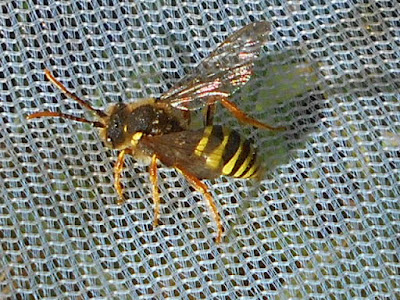Be that as it may, there was a chilly wind blowing earlier today and I wimpishly decided only to venture as far as our local pocket park. Butterflies were on the wing including Speckled Wood, Pararge aegeria, with one specimen graciously posing whilst I took a picture.
This is a widespread butterfly with the larval food-plants being common grasses such as Cock's Foot, Yorkshire Fog, and so on. It can have up to three broods per year, so in favourable conditions it can multiply quickly.
 |
This Speckled Wood was one of many insects basking in the sun.
Stefen Hill Pocket Park, Daventry. 11 April, 2019
|
In sheltered conditions insects were basking in the sun and this Noon Fly, Mesembrina meridiana, was one to take advantage, using the park notice board for its sunbathing.
 |
This Noon Fly was taking advantage of the Park's notice board.
11 April, 2019
|
It has a curiously tautologous name for Mesembrina comes from the Greek mesembria, midday, whilst meridiana is simply the feminine of the Latin word meridianus, which also means midday.
I swept my net through some Cow Parsley in an attempt to catch a wolf spider. I failed but in my net found this wasp-like bee, one of a group known as Nomad Bees.
 |
| A nomad bee turned up in my net. |
This particular species is Gooden's Nomad Bee, Nomada goodeniana, widespread across England and Wales, and just making it as far as the Scottish borders. Nomad bees are kleptoparasites, their victims being Andrena bee species.
 |
It proved to be Gooden's Nomad Bee.
Stefen Hill Pocket Park, 11 April, 2019
|
Among a welter of insect recorded was a specimen of Phryno vetula, a bristly yellow-legged fly which is a parasite of certain looper caterpillars. It may be a first record from Northamptonshire. It is certainly the first specimen I have encountered.
No comments:
Post a Comment